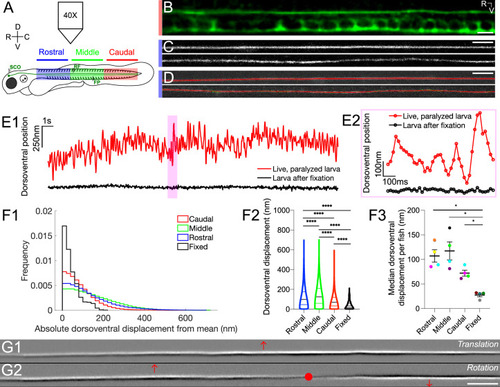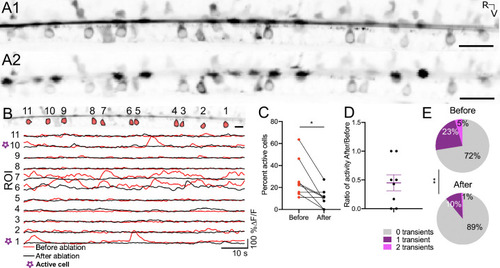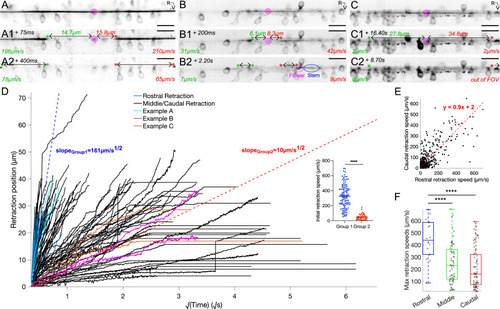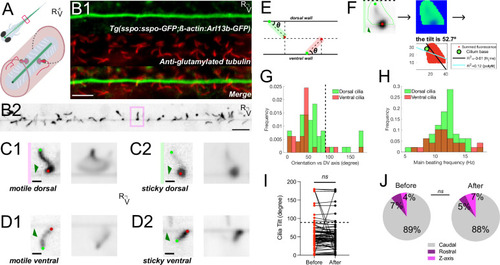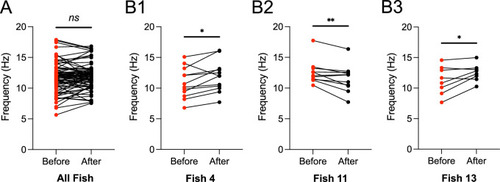- Title
-
The Reissner fiber under tension in vivo shows dynamic interaction with ciliated cells contacting the cerebrospinal fluid
- Authors
- Bellegarda, C., Zavard, G., Moisan, L., Brochard-Wyart, F., Joanny, J.F., Gray, R.S., Cantaut-Belarif, Y., Wyart, C.
- Source
- Full text @ Elife
|
The Reissner fiber under tension exhibits spontaneously dynamic behavior over the dorsoventral axis in the central canal. ( |
|
The Reissner fiber enhances spontaneous calcium activity in ventral CSF-cNs. ( |
|
Reissner fiber photoablation reveals different modes of relaxation under tension ( |
|
The Reissner fiber interacts with beating cilia protruding in the central canal. (A) Schematic illustrating motile cilia (white) lining the walls of the central canal beside CSF-cNs (red) with RF (green) bathing in the spinal cord of a zebrafish larva. (B1) Z-stack projection in the sagittal plane showing the immunostaining against GFP and glutamylated tubulin in a Tg(sspo:sspo-GFP;-ß-actin:Arl13b-GFP) larva fixed at 3 dpf revealing respectively RF and cilia labeled by the ß-actin promoter (both in green here) and motile cilia (red). Rostral to the left, ventral displayed on the bottom. (B2) Single optical section in the sagittal plane showing RF surrounded by cilia protruding in the central canal in 3 dpf Tg(sspo:sspo-GFP;ß-actin:Arl13b-GFP) paralyzed larva out of the streaming video acquired at 40 Hz using spinning disk confocal microscopy setup equipped with a 40X objective. (C1) Right: example single optical section of a dorsal motile cilium from the highlighted box in (B1). Dark green arrow indicates RF. Light green and red dots indicate the base and tip of the cilium, respectively. Left: average projection over 25 s of the dorsal cilium brushing against RF. (C2) Right: example single optical section of a dorsal motile cilium whose tip tends to stick to RF. Left: average projection over 25 s of the dorsal cilium. (D1) Right: example single optical section of a ventral motile cilium whose tip tends to brush against RF. Left: average projection over 25 s of the ventral cilium. (D2) Right: example single optical section of a ventral motile cilium whose tip tends to stick to RF. Left: average projection over 25 s of the ventral cilium. (E) Schematic illustrating the geometric calculation of ciliary orientation versus the dorsoventral axis. (F) Representative analysis process for the dorsal cilium in (C2). A mask was first drawn over a single cilium to calculate the frequency and orientation in a specific region of interest (left). A temporal mean of that region (middle) was then used to calculate the orientation of the cilium in respect to the dorsoventral axis (right; see also Materials and methods). (G1) Distribution of the orientation in respect to the dorsoventral axis of dorsal mean ± standard deviation provided hereafter: (64.8° ± 44.4°; N=49 cilia across 8 fish) and ventral (43.9° ± 35.8°; N=27 cilia across 9 fish) motile cilia. (G2) Distribution of main ciliary beating frequency for dorsal (mean ± standard deviation provided hereafter: 11.8 Hz ± 2.7 Hz; N=49 cilia) and ventral (11.6 Hz ± 2.8 Hz; N=27 cilia) motile cilia. (H) The orientation of motile cilia in the central canal was not significantly different after RF photoablation (mean ± standard deviation provided hereafter: 55.1° ± 39.3°) from that before RF photoablation (57.4° ± 42.5°), illustrating that cilia orientation is, on average, not significantly affected by RF photoablation (N=76 cilia from 9 fish; paired two-tailed t-test: p > 0.3). (J) Overall rostrocaudal polarity of motile cilia remained similar before and after RF photoablation, with about 90% of motile cilia polarized toward the caudal end of the fish, and the remaining 10% either polarized toward the dorsal end of the fish or beating in the Z axis (N=76 cilia from 9 fish; paired two-tailed t-test: p > 0.3). ns = not significant. Scale bar is 10 μm (B1, B2) and 2 μm (C1, C2, D1, D2). |
|
Changes in the main ciliary beating frequency varied from fish to fish in response to RF photoablation. ( |
|
Motile cilia position profile differs with Reissner fiber dorsoventral oscillation position. ( |
|
Example cilia analysis process. ( |

